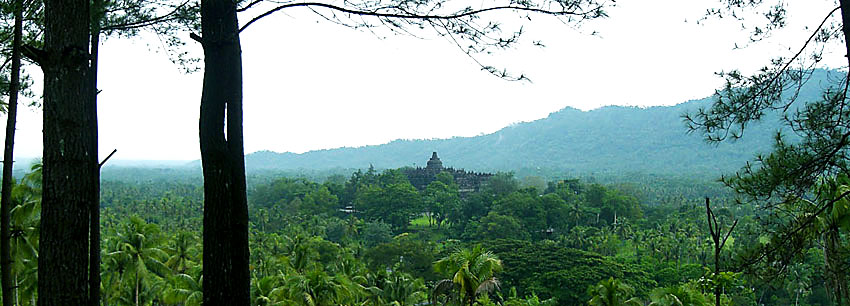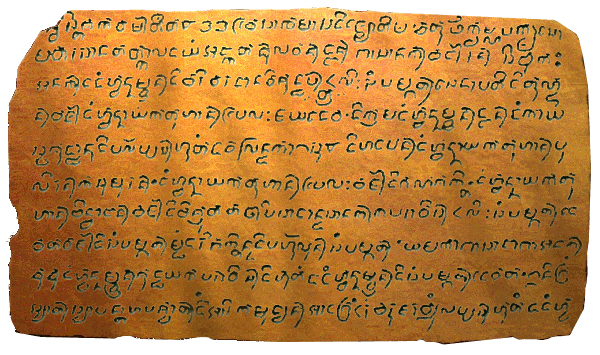|
Kalasan Inscription
The Kalasan inscription is an inscription dated 700 Saka (778 CE), discovered in Kalasan village, Sleman Regency, Yogyakarta, Indonesia. The inscription was written in Sanskrit with Nāgarī script, Pranagari script (Northern India). This is the first inscription discovered in Indonesia that mentioned the dynasty, dynastic name of Sailendra as ''Sailendravamça''. Contents The inscription mentioned ''Guru Sang Raja Sailendravamçatilaka'' (Teacher of the King, the Jewel of Sailendra, the Sailendra family) who succeeded in persuading Panangkaran, Maharaja Tejapurnapana Panangkaran (in other part of the inscription also called Kariyana Panangkaran) to construct a holy building for (Bodhisattvadevi) Tara and also build a Vihara (monastery) for Buddhist monks from Sailendra family's realm. Panangkaran donated the ''Kalaça'' village to Sangha (Buddhism), Sangha (Buddhist monastic community).Soetarno, Drs. R. second edition (2002). "Aneka Candi Kuno di Indonesia" (Ancient Temples in I ... [...More Info...] [...Related Items...] OR: [Wikipedia] [Google] [Baidu] [Amazon] |
Canggal Inscription
The Canggal inscription is a Sanskrit inscription dated to 732, discovered in the Gunung Wukir temple complex in Kadiluwih village, Salam, Magelang Regency, Central Java, Indonesia. The inscription is written in the Pallava alphabet. The inscription documents an edict of Sanjaya, in which he declared himself the universal ruler of the Mataram Kingdom. Content The inscription describes the erection of a ''lingam'' (the symbol of Shiva) in the country of Kunjarakunja, by Sanjaya's order. The ''lingam'' is sited on the noble island of Yava (Java), which the inscription describes as "rich in grain and gold mines". Yawadwipa ("Java island"), and had long been under the rule of the wise and virtuous king Sanna, but fell into disunity after his death. Amid a period of confusion Sanjaya, son of Sannaha (the sister of Sanna) ascended to the throne. Sanjaya mastered holy scriptures, and martial arts, and displayed military prowess. After the conquest of neighboring areas, his reign was ... [...More Info...] [...Related Items...] OR: [Wikipedia] [Google] [Baidu] [Amazon] |
Shailendra Dynasty
The Shailendra dynasty (, derived from Sanskrit combined words ''Śaila'' and ''Indra'', meaning "King of the Mountain", also spelled Sailendra, Syailendra or Selendra) was the name of a notable Indianised dynasty that emerged in 8th-century Java, whose reign signified a cultural renaissance in the region. The Shailendras were active promoters of Mahayana Buddhism and covered the Kedu Plain of Central Java with Buddhist monuments, one of which is the colossal stupa of Borobudur, now a UNESCO World Heritage Site. The Shailendras are considered to have been a thalassocracy and ruled vast swathes of maritime Southeast Asia; however, they also relied on agricultural pursuits, by way of intensive rice cultivation on the Kedu Plain of Central Java. The dynasty appeared to be the ruling family of the Mataram Kingdom of Central Java, and for some period, the Srivijaya Kingdom in Sumatra. The inscriptions created by Shailendras use three languages; Old Javanese, Old Malay, and San ... [...More Info...] [...Related Items...] OR: [Wikipedia] [Google] [Baidu] [Amazon] |
8th-century Inscriptions
The 8th century is the period from 701 (represented by the Roman numerals DCCI) through 800 (DCCC) in accordance with the Julian Calendar. In the historiography of Europe the phrase the long 8th century is sometimes used to refer to the period of circa AD 660–820. The coast of North Africa and the Iberian Peninsula quickly came under Islamic Arab domination. The westward expansion of the Umayyad Caliphate, Umayyad Empire was famously halted at the Siege of Constantinople (718), siege of Constantinople by the Byzantine Empire and the Battle of Tours by the Franks. The tide of Arab conquest came to an end in the middle of the 8th century.Roberts, J., ''History of the World (book), History of the World'', Penguin, 1994. In Europe, late in the century, the Vikings, seafaring peoples from Scandinavia, begin raiding the coasts of Europe and the Mediterranean, and go on to found several important Monarchy, kingdoms. In Asia, the Pala Empire is founded in Bengal. The Tang dynasty ... [...More Info...] [...Related Items...] OR: [Wikipedia] [Google] [Baidu] [Amazon] |
Sanskrit Inscriptions In Indonesia
A good number of inscriptions written in Sanskrit language have been found in maritime Southeast Asia, notably in Malaysia and Indonesia. "Early inscriptions written in Indian languages and scripts abound in Southeast Asia. ..The fact that southern Indian languages didn't travel eastwards along with the script further suggests that the main carriers of ideas from the southeast coast of India to the east - and the main users in Southeast Asia of religious texts written in Sanskrit and Pali - were Southeast Asians themselves. The spread of these north Indian sacred languages thus provides no specific evidence for any movements of South Asian individuals or groups to Southeast Asia. Notable inscriptions Kutai inscriptions The oldest known inscriptions in Indonesia are the Kutai inscriptions, or the Muarakaman inscriptions, which are those on seven stone pillars, or '' yupa'' (“sacrificial posts”), found in the eastern part of Borneo, in the area of Kutai, East Kalimantan ... [...More Info...] [...Related Items...] OR: [Wikipedia] [Google] [Baidu] [Amazon] |
Kedu Plain
Kedu Plain, also known as Progo River Valley, is the fertile volcanic plain that lies between the volcanoes Mount Sumbing and Mount Sundoro to the west, and Mount Merbabu and Mount Merapi to the east. It roughly corresponds to the present-day Magelang and Temanggung Regency of Central Java, Indonesia. Its northern border is limited by the hills of Kendal and Mount Ungaran. The plain also borders the Menoreh Hills in the southwest and Prambanan Plain in the southeast. The Progo River runs through the center of this plain, from its source on the slope of Mount Sundoro to the southern coast of Java facing the Indian Ocean. It has been a significant location in Central Javanese history for over a millennium, as it contains traces of the Sailendra dynasty as well as Borobudur and associated locations. During the colonial Dutch East Indies period, the Kedu Plain was located in the Kedu Residency, which at that time covered what are now the Magelang Regency, Magelang City, and ... [...More Info...] [...Related Items...] OR: [Wikipedia] [Google] [Baidu] [Amazon] |
Indonesian Esoteric Buddhism
Indonesian Esoteric Buddhism was the tradition of Esoteric Buddhism found in Maritime Southeast Asia which emerged in the 7th century along the maritime trade routes and port cities of the Indonesia, Indonesian islands of Java and Sumatra as well as in Malaysia. These esoteric forms were spread by Pilgrims and Tantric masters who received royal patronage from royal dynasties like the Shailendra dynasty, Sailendras and the Srivijaya.Acri, Andrea. Esoteric Buddhism in Mediaeval Maritime Asia: Networks of Masters, Texts, Icons, page 7. This tradition was also linked by the maritime trade routes with Indian Vajrayana, Tantric Buddhism in Sinhala Kingdom, Sinhala, Chams, Cham and Khmer Empire, Khmer lands and in China and Japan, to the extent that it is hard to separate them completely and it is better to speak of a complex of "Esoteric Buddhism of Mediaeval Maritime Asia." Many key Indian port cities saw the growth of Esoteric Buddhism, a tradition which coexisted alongside Shaivism. J ... [...More Info...] [...Related Items...] OR: [Wikipedia] [Google] [Baidu] [Amazon] |
Candi Of Indonesia
A candi (, ) is a Hindu temple, Hindu or Buddhist temple in Indonesia, mostly built during the ''Zaman Hindu-Buddha'' or "Indianized kingdom, Hindu-Buddhist period" between circa the 4th and 15th centuries. The ''Kamus Besar Bahasa Indonesia'' defines a ''candi'' as an ancient stone building used for worship, or for storing the ashes of cremated Hindu or Buddhist kings and priests. Archaeology of Indonesia, Indonesian archaeologists describe ''candis'' as sacred structures of Hindu and Buddhist heritage, used for religious rituals and ceremonies in Indonesia. However, ancient secular structures such as gates, urban ruins, pools and bathing places are often called ''candi'' too, while a shrine that specifically serves as a tomb is called a ''cungkup''. In Hindu Balinese architecture, the term ''candi'' refers to a stone or brick structure of single-celled shrine with portico, entrance and stairs, topped with pyramidal roof and located within a ''Balinese temple, pura''. It is oft ... [...More Info...] [...Related Items...] OR: [Wikipedia] [Google] [Baidu] [Amazon] |
Buddhism In Indonesia
Buddhism has a long history in Indonesia, and it is one of the six recognized religions in the country, along with Islam, Christianity (Protestantism and Catholicism), Hinduism and Confucianism. According to 2023 estimates roughly 0.71% of the total citizens of Indonesia were Buddhists, numbering around 2 million. Most Buddhists are concentrated in Jakarta, Riau, Riau Islands, Bangka Belitung, North Sumatra, and West Kalimantan. These totals, however, are probably inflated, as practitioners of Taoism, Tridharma, Yiguandao, and other Chinese folk religions, which are not considered official religions of Indonesia, likely declared themselves as Buddhists on the most recent census. Today, the majority of Buddhists in Indonesia are Chinese and other East Asians, but small communities of native Buddhists (such as Javanese, Tenggerese, Sasak, Balinese, and Alifuru) also exist. History Antiquity Buddhism is the second oldest outside religion in Indonesia after Hin ... [...More Info...] [...Related Items...] OR: [Wikipedia] [Google] [Baidu] [Amazon] |
Tri Tepusan Inscription
The Tri Tepusan inscription is an inscription discovered in Kedu Plain, Temanggung Regency, Central Java, Indonesia, dated from 842 CE. This inscription is linked with the Borobudur Buddhist monument. Contents The inscription mentioned the ''sima'' (tax-free) lands in Tri Tepusan village awarded by Çrī Kahulunnan (Pramodhawardhani) to ensure the funding and maintenance of a ''Kamūlān'' called ''Bhūmisambhāra''. ''Kamūlān'' itself from the word ''mula'' which means 'the place of origin', a sacred building to honor the ancestors, probably the ancestors of the Sailendras. Casparis suggested that ''Bhūmi Sambhāra Bhudhāra'' which in Sanskrit means "The mountain of combined virtues of the ten stages of Boddhisattvahood", was the original name of Borobudur. See also *Canggal inscription (732) *Kalasan inscription (778) *Kelurak inscription (782) *Karangtengah inscription (824) *Mantyasih inscription (907) *Laguna Copperplate Inscription (900) *Shivagrha inscription (856) *Budd ... [...More Info...] [...Related Items...] OR: [Wikipedia] [Google] [Baidu] [Amazon] |
Sojomerto Inscription
Sojomerto inscription (; ; ; ) is an inscription discovered at the Sojomerto village of Reban in the Batang Regency of Central Java, Indonesia. Written in Sanskrit using the Brahmic writing system (most probably Old Javanese), it was initially dated to 7th century, but later redated, on palaeographic grounds, to the early 9th century. The inscription is currently '' in situ'' or on location, and Shivaist in nature. The inscription was carved on an andesite Andesite () is a volcanic rock of intermediate composition. In a general sense, it is the intermediate type between silica-poor basalt and silica-rich rhyolite. It is fine-grained (aphanitic) to porphyritic in texture, and is composed predomina ... stone 43 cm wide, 7 cm thick, and 78 cm tall. [...More Info...] [...Related Items...] OR: [Wikipedia] [Google] [Baidu] [Amazon] |
Laguna Copperplate Inscription
The Laguna Copperplate Inscription is an official acquittance ( debt relief) certificate inscribed onto a copper plate in the Shaka year 822 ( Gregorian A.D. 900). It is the earliest-known, extant, calendar-dated document found within the Philippines. The plate was found in 1987 by a laborer near the mouth of the Lumbang River in Wawa, Lumban, Laguna, in the Philippines. The inscription was mainly written in Old Malay using the Early Kawi script, with several technical Sanskrit words and either Old Javanese or Old Tagalog honorifics. After it was found, the text was first translated in 1991 by Antoon Postma, a Dutch anthropologist and Hanunó'o script researcher. The inscription documents the existence and names of several surrounding states as of A.D. 900, such as the Tagalog city-state of Tondo. Some historians associate the toponym ''Medang'' in this inscription regarding the Medang palace in Java at that time, although the name is a common term of Malayo-Polyn ... [...More Info...] [...Related Items...] OR: [Wikipedia] [Google] [Baidu] [Amazon] |








